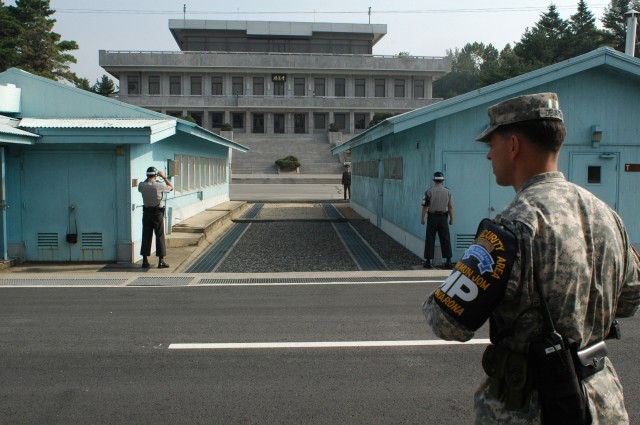
WASHINGTON (Army News Service, Oct. 10, 2006) - "It's a country that time has forgotten," said Special Operations Command, Korea, Command Sgt. Maj. Richard Kimmich of North Korea.
"We have to be prepared for war 365 days a year, because we never know when Kim Jong-il [son of the late, but delegated "eternal" North Korean president Kim II-Sung] will say, 'We need to unify Korea today,'" Kimmich said.
The possibility of war is never far from people's minds, Kimmich said. A peace treaty between North and South Korea was never signed following the 1950 to 1953 Korean War.
And if the North chooses to invade there will be little warning, said Kimmich, whose 82-person headquarters would swell to some 500 to form the Combined Unconventional Warfare Task Force.
North Korea has the fourth largest army in the world - composed of some 1.2 million active-duty soldiers, more than 13,000 artillery systems and one of the largest submarine fleets in the world, according to U.S. State Department records.
"In 1991, when the United States and other nations were reducing the size of their military forces, North Korea focused on building up its force," Kimmich said.
In 1991, too, North Korea had 40 percent of its army positioned along the demilitarized zone some 25 miles north of South Korea's capital, Seoul, which is also home to U.S. Forces, Korea's Yongsan Garrison.
Today, 70 percent of the North Korean army is positioned at the DMZ, Kimmich said. And U.S. State Department reports indicate that the North "has perhaps the world's second largest special operations force, designed for insertion behind the lines in wartime."
Additionally, the reports reveal "North Korean forces have a substantial numerical advantage over the South (between 2 and 3 to 1) in several key categories of offensive weapons - tanks, long-range artillery and armored personnel carriers."
Ironically, nighttime satellite pictures of the divided peninsula show a bleak, black image of the North, which accommodates some 23 million people, versus a bright, vibrant image of democratic South Korea, or the Republic of Korea, population about 48 million.
To stay prepared for crises and war, SOCKOR participates in six training exercises annually with ROK Special Warfare Command forces, including a counterterrorist exercise that focuses on marksmanship training, said Eighth U.S. Army spokesman Maj. Jerome Pionk.
Two of the exercises are Joint Chiefs of Staff-level exercises that involve all U.S. and ROK special operations forces, said Sgt. Maj. Jack Hagan of the 39th Special Forces Detachment, Det. K.
Attached to the 1st Special Forces Group, the detachment's 16 Soldiers work at 11 locations on the Korean peninsula, Hagan said.
"[U.S. SF Soldiers have] been training the ROK soldiers for 48 years, so we no longer concentrate on basic Soldier skills. Most of the training we conduct is concentrated on advanced skills and interoperability," he said.
It includes courses such as fast-rope master, jumpmaster, combat dive supervisor, water infiltration, over-the-water navigation, tactical air control, military free fall and airfield seizure, among others.
"As liaisons to ROK special forces units, we teach their teams to call in U.S. strike aircraft and coordinate for other U.S. assets, such as Army night aviation and intelligence," Hagan added.
Recently, ROK SF soldiers parachuted onto an airfield at low altitude at night and took control of the runway, allowing mock follow-on forces to come in within 30 minutes, Hagan said. "That was significant, because it was something they hadn't previously done."
Det. K Soldiers, master sergeants who serve as advisers to ROK army generals, trained approximately 1,000 ROK SF soldiers last year, Hagan said, using the "train-the-trainer" technique.
"We've maintained a legacy with Korean special forces, who supported us immediately after the Korean War and in Iraq and Afghanistan," said Col. Simeon Trombitas, commander, SOCKOR.
"As we learn lessons from our combat experiences, we share those with the Korean army. And we train them on changing systems," Trombitas said.
"The July 2006 missile launches by North Korea further demonstrated the need for the U.S. military presence in South Korea as a deterrent on the peninsula," he added.
"The U.S. and ROK special operations soldiers are at the highest level of proficiency I've ever seen. I have no doubts they're ready to do their nations' bidding," Trombitas concluded.

Social Sharing